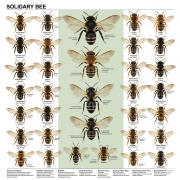The pollination and overall health of ecosystems are greatly influenced by Solitary bees, who constitute more than 90% of the bee species on Earth. In order to better understand and preserve these underappreciated insect heroes, we have created this Solitary Bee ID Chart to assist you in recognizing their essential traits, nesting behaviors, and habitats.
How Do Solitary Bees Work?
A queen-worker hierarchy and colony life are not features of solitary bees’ social structure. The mother bees lay their eggs in a nest she builds herself, which she may do in the ground or in a hollow stem of a plant. She then supplies her young with nectar and pollen. Most of them are essential pollinators and aren’t hostile.
An Introduction to This ID Chart
- Color Patterns— Look at the abdomen for strikes of metallic sheen, rainbow hair, or stripes.
- Nesting Behavior — Ground-nesting vs. cavity-nesting.
- Seasonality — A lot of them only come alive for a short while in the spring and summer.
Important Sorts of Solitare Bees
Here are the following:
-
 Andrenidae Bees: The Miners
Andrenidae Bees: The Miners
For nesting, they dig a hole on sand or along a bank. These little, fuzzy foragers are a common sight in the early spring.
-
Osmia Bees: The Mason Bees
They create a nest by filling up any holes that already exist and cover them with mud. Their distinctive marks include green or blue-colored metallic bodies with under belly pollen sacks.
-
Megachile Leafcutter Bees
When nesting, these bees use circular pieces of leaves to line the cavities. A strong beak and pollen stored beneath the belly make this an identifiable species.
-
Collete: The Cellophane Bees
While nesting, they use a secretion that is waterproof to line their ground or cavity nests. Dark bodies with pale abdominal bands are identified.
-
Anthidium: The Wool Carder Bees
Lining nests with plant hairs (“wool”) is an important part of producing healthy nests. Their identifying features are bare, wasp-like stripes accompanied with carder behavior.
Resources and Charts for Solitary Bees
Look over the HelpSaveBees.co.uk Solitary Bee ID Chart page for a detailed visual reference. This great resource has high-quality pictures and thorough descriptions of how many species of solitary bees look, how they build their nests, and when they are active. This helps people identify the bees correctly.
Summing Up
Our ID Chart on Solitary Bee is a good source of knowing facts about these insects and the proper way for their identification. Understanding their behavior, physical features, and specific functions in the environment can help us to protect them and our planet.

 Andrenidae Bees: The Miners
Andrenidae Bees: The Miners